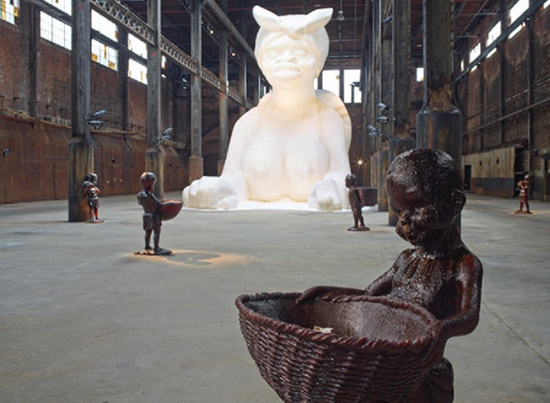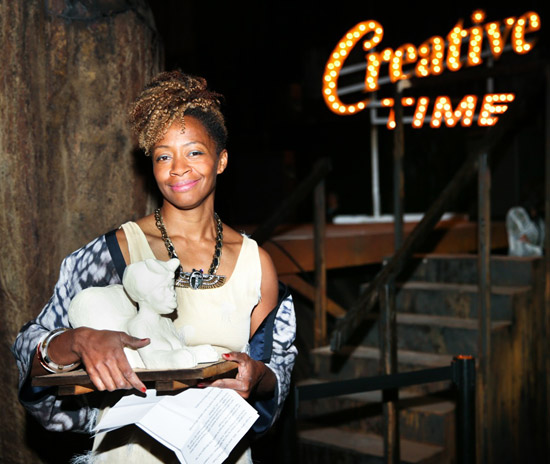Looking back over thousands of years of history, artist Kara Walker--who might be called the Anti-Antebellum and is best known for her explicit cut-paper silhouettes--has seized on the massive sphinx of ancient Egypt as her vessel for telling a radical history of race, culture, slavery, stereotypes, and refined sugar as a symbol of wealth.
Taking on the challenge of filling the massive abandoned Domino Sugar Factory on the East River in the Williamsburg section of Brooklyn--five stories high and more than a football field long--Walker has created an otherworldly installation of a Sugar Baby Mammy and attending “Subtleties,” smaller statues of broken, melting resin molasses boys based on Medieval edible statues.
The full title is “A Subtlety or the Marvelous Sugar Baby, an Homage to the unpaid and overworked Artisans who have refined our Sweet tastes from the cane fields to the Kitchens of the New World on the Occasion of the demolition of the Domino Sugar Refining Plant.”
The spectacle leaves visitors speechless, awestruck, giddy with the sight and smell of the burnt sugar that coats the walls from decades of processing the raw brownish cane into sweet refined ivory granules.
To see images from the show, view our slideshow:
View Slideshow.

The "Sugar Baby" installation by Kara Walker. Photo courtesy Creative Time.
.
In her career, Walker has repeatedly used imagery evoking racism and piercing its stereotypes at the same time, creating ambiguous scenes of violence and sex that work on multiple levels. The mix of emotions is played out in the attending “Subtleties” and in the mammoth “Sugar Baby.’ Like a set from a Quentin Tarantino film mashed up with Cecil B. De Mille, the pastiche of spectacle and history swirls in the air like rancid cotton candy.
.
.
In the two decades since Walker’s groundbreaking show at the Drawing Center in New York when she was just 24, the artist has become a polarizing art world figure, a pivotal female African-American visual artist who has achieved unmatched global success. Her cut-paper silhouettes have been exhibited and purchased by international museums, and continue the uncomfortable dialogue that the history and the suffering of slavery must be acknowledged.
“In some ways, doing a project like this is a bit of a nose-thumbing at detractors, naysayers, haters,” Ms. Walker said of her Domino sphinx, "because this time the Negress holds the power. Basically, it was blood sugar. Like we talk about blood diamonds today, there were pamphlets saying this sugar has blood on its hands.”
.

A "Subtlety" holds a basket filled with broken molasses chunks. Photo by Sandra Hale Schulman.
.
Walker explained that to process sugar the cane had to be fed into large mills by hand. It was dangerous work, and the slaves compelled to do it lost hands, whole limbs and lives, a fact that helps explain the broken bits of the “Subtleties” offered up in baskets and slung over shoulders. Sugar was also once a highly prized commodity, expensive and precious because of its rarity until the invention of artificial sweeteners.
“Sugar crystallizes something in our American soul,” Walker says. “It is emblematic of all industrial processes, and of the idea of becoming white. White being equated with pure and ‘true’. It takes a lot of energy to turn brown things into white things. A lot of pressure.”
.

Kara Walker with the "Sugar Baby" model. Courtesy Creative Time.
.
Tapped by the non-profit public arts organization Creative Time, Walker was given an enormous stage to flesh out her in-your-face ideas, but one that will be destroyed with the factory when the show ends in July.The site of the plant will be home to high rise apartments and condos.
The line to get into the popular exhibit has been stretching over more than two blocks, with a wait of about 20 minutes. The outside view is astonishing, with flashes of the ornate brick factory abutting the busy East River, Williamsburg Bridge and sleek high rises of the Manhattan skyline.
After entering, the senses can be overwhelmed by the sheer scale of the space. The plant of the Domino Sugar factory was shuttered a decade ago, yet its crumbling walls still drip with molasses.Walker’s installation is 35 feet high and it took four tons of donated sugar to create.
The refinery itself is an integral part of the history of sugar in the U.S. Built by the Havemeyer family in 1856, by 1870 it was producing more than half of the sugar in America, which means more than 1,200 tons of the stuff every day. Every inch of the room that holds the Sugar Baby is coated in that history.
To see images from the show, view our slideshow:
View Slideshow.
BASIC INFO: The Domino Sugar Factory is located at South 1st Street at Kent Avenue, Williamsburg, NY 11211. The exhibition is open through July 6, Fridays 4-8 pm, Saturdays and Sundays noon to 6.
Art21, a producer of contemporary art documentaries, was given access to the making of Kara Walker’s installation at Domino. Here is the link to the short film they created.
___________________________
Copyright 2014 Hamptons Art Hub LLC. All rights reserved.

